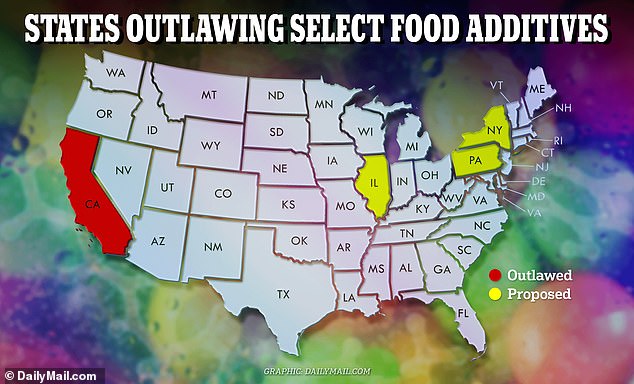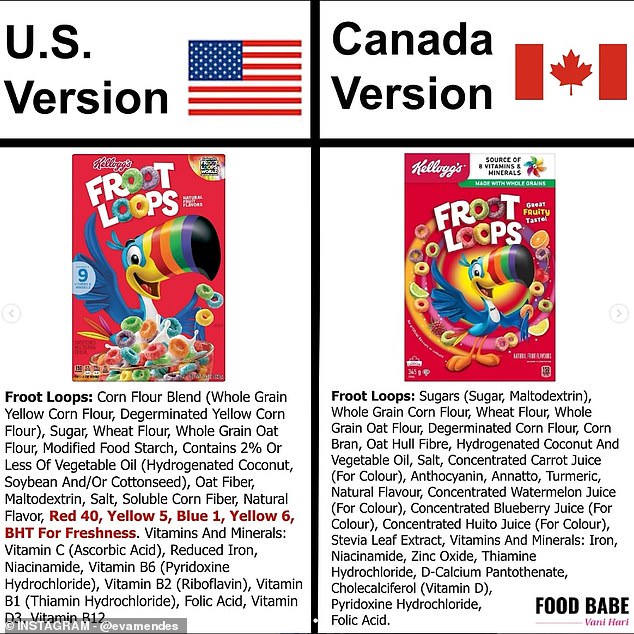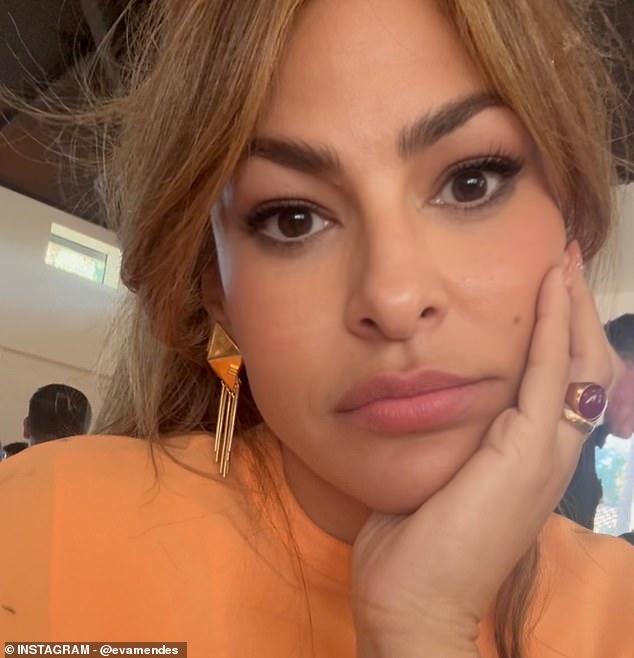Former FDA food expert reveals why Kellogg’s Froot Loops is the worst cereal in the US – amid calls for a ban on cancer chemicals
A leading food safety expert has labeled Kellogg’s Froot Loops the worst breakfast cereal in the US – amid protests over the ingredients in the product.
Former FDA food chief Dr. Darin Detwiler told DailyMail.com that the colorful rings are “heavily processed and contain high levels of added sugars, artificial colors and preservatives, which are linked to health problems.”
The morning snack contains 12.35 grams of sugar per serving (one cup), or three teaspoons, which is almost half of a child’s daily intake.
Dr. Detwiler notes that most children “consume much more than the recommended serving size, as one cup is not a realistic amount.”
But more concerning are the additives that Froot Loops contain. Dr. Detwiler said Red 40, a dye that gives the hoops their neon red color, was the most concerning.
Are banned in several European countries due to its link to it hyperactivity and cancerand are not present in most international products, such as those in Australia and Canada.
He says the worst dye in Froot Loops is Red 40, whatever that was has been banned in several European countries due to its link to it hyperactivity and cancerand are not present in most international products, such as those in Australia or Europe.
A leading food safety expert has labeled Kellogg’s Froot Loops the worst breakfast cereal on the US market.
Together with campaigners, especially actress Eva Mendes, Dr. Detwiler calls on Kellogg’s to “consider reformulating their products to reduce the use of artificial additives, colorings and high sugar levels.”
He continues, “With growing concerns about the long-term health effects of processed ingredients, especially those linked to cancer risks such as certain dyes in food, Kellogg’s has the opportunity to lead the way in healthier food production.
“By focusing on cleaner ingredients and transparency, they can address consumer concerns and transition to healthier, more sustainable food options.”
Some of the other grains that Dr. Detwiler recommends avoiding are Lucky Charms because of their high sugar content and artificial colorings, and Frosted Flakes because of their high sugar content.
“These grains may also contain food colorings linked to potential health risks, which is a concern if they are consumed frequently, especially by children,” he adds.
Dr. Detwiler says that all of these grains “should only be considered an occasional treat and certainly should not be consumed daily.”
New York-based nutritionist Lisa Moskovitz agreed with this portion suggestion, telling DailyMail.com, “Even though these sugary grains are harmless in very small amounts, if consumed regularly they can pose a health problem.”
Dr. Detwiler’s comments follow Eva Mendes’ demand the removal of ‘harmful’ food dyes in popular American children’s cereals.
The 50-year-old actress went to Instagram last week to warn about artificial colors in Kellogg’s breakfast cereals like Froot Loops.

California has banned six food additives, while states such as New York and Illinois have introduced similar legislation
Dyes such as red 40 and yellow 5 are banned in many parts of the world, but persist in American versions.
Kellogg’s promised nearly a decade ago to remove artificial colors and ingredients from all its cereals by 2018, but has yet to deliver on that promise.
Mendes, who shares two daughters with husband Ryan Gosling, called on Kellogg’s to remove these dyes and urged her 6.6 million followers to join a “peaceful march to Kellogg’s headquarters.”
That protest took place Tuesday outside the cereal giant’s headquarters in Michigan, where dozens of activists delivered a petition with nearly 400,000 signatures.
Mendes wrote on Instagram: “I grew up eating grains. I still love it, but I won’t eat @kelloggsus anymore after I found out that so many of the ingredients they use here in the US are BANNED in other countries.
‘Why? Because they are harmful to children.’
Mendes compared Froot Loops nutrition labels in the US and Canada.
The US variant contains red 40, yellow 5, blue 1, yellow 6 and butylated hydroxytoluene (BHT), which have been linked to health problems in children.
Canadian Froot Loops replaced these dyes with concentrated blueberry, carrot and watermelon juices.
In a statement, Kellogg’s said: “Our products – and the ingredients we use to make them – comply with all applicable relevant laws and regulations.”
‘We remain committed to transparent labeling of our ingredients so that consumers can easily make choices about the food they buy.’
The company also claims that 85 percent of its cereals contain no colorants from artificial sources.

Mendes shared the above comparison of Froot Loops in the US vs. Canada

Actress Eva Mendes took to Instagram last week to call on Kellogg’s to remove “harmful” food dyes and additives from its breakfast cereals
Red 40, yellow 5 and 6 and blue 1 are dyes used to give grains and other processed foods their bright colors.
They are theorized to worsen attention problems in children, leading to EU regulators requiring product manufacturers to say that dyes “may have a negative effect on activity and attention in children.”
A Report 2021 from California’s Environmental Protection Agency also linked artificial colorings to “hyperactivity and other neurobehavioral problems” in some children, especially those with ADHD or other existing behavioral disorders.
Red 40, Yellow 5 and Yellow 6 also contain benzidene, a carcinogenic substance for humans and animals that is permitted in low concentrations.
According to the FDA, ingesting free benzidine increases the risk of cancer to just below the “concern” threshold, or one cancer in 1 million people.
BHT, meanwhile, is an additive used to keep food fresh. It can also be found in beauty products such as lip glosses and lotions, as well as in chewing gum.
The research on BHT is mixed, although some studies have suggested that long-term exposure causes liver and thyroid problems in mice by disrupting hormones.
Several states have taken steps to ban or restrict these additives. Earlier this year, California became the first state to ban schools from serving food containing Red 40, Yellow 5, Yellow 6, Blue 1, Blue 6 and Green 3.
In March, New York state officials called for the removal of Red Dye No. 3, propylparaben, brominated vegetable oil (BVO), potassium bromate, titanium dioxide, azodicarbonamide and BHA.
